Rationale of the Week | Best treatment for abrasion?

For last week’s practice question, we quizzed test takers on the best treatment for abrasions 65% of respondents chose the best answer. We want to share this important information, so you can pass it on to people living with diabetes and your colleagues, plus prepare for exam success!
Before we start though, if you don’t want any spoilers and haven’t tried the question yet, you can answer it below: Answer Question
Question: JR is 38 years old and takes insulin twice a day. They mention they went to the bathroom at night, lost their balance, and scraped their shin. They put a band-aid on it, but want you to take a look.
What is the best approach to treat the abrasion?
Answer Choices:
- Clean carefully with sanitizing gel, apply topical antibiotic and observe for signs of infection.
- Discuss creating a safe path to the bathroom at night and assess the abrasion for severity.
- Replace the band-aid with gauze and suggest they make an appointment with podiatry.
- Take a photo of the abrasion, wash with soap and water, and apply iodine around the perimeter.
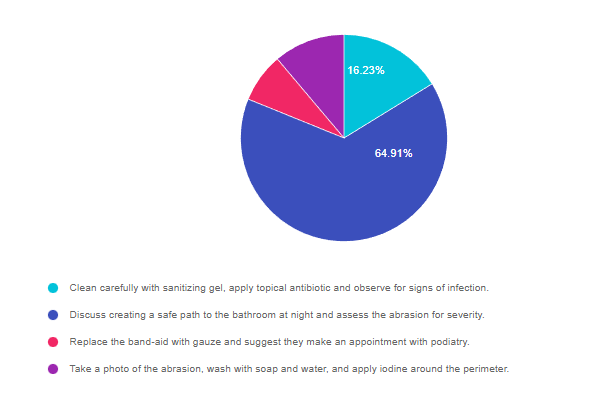
As shown above, the most common choice was option 2, the second most common answer was option 1, then option 4, and finally option 3.
Getting to the Best Answer
Answer 1 is incorrect. 16.23% chose this answer, “Clean carefully with sanitizing gel, apply topical antibiotic and observe for signs of infection.” This is a juicy answer, but not the best answer for this situation for two main reasons. Applying topical antibiotic is a great idea, but generally, abrasions are cleansed with soap and water instead of sanitizing gel. In addition, this answer did not address the core issue, of improving safety when going to the bathroom at night.
Answer 2 is correct. 64.91% of you chose this answer, “Discuss creating a safe path to the bathroom at night and assess the abrasion for severity.” YES, GREAT JOB, this is the best answer. Many lower extremity falls, scrapes and injuries happen on the way to the bathroom when it is dark. It is important to make sure people have a safe path, including night lights and removal of any potential fall risks, especially for older people with balance issues.
Answer 3 is incorrect. 7.71% of respondents chose this answer, “Replace the band-aid with gauze and suggest they make an appointment with podiatry.” It is important to evaluate and treat the abrasion, but it does not warrant an automatic referral to the podiatrist, especially since it is on the shin. Also, this question does not provide enough details about the severity of the wound to determine if further treatment is required.
Finally, Answer 4 is incorrect. 11.16% chose this answer, “Take a photo of the abrasion, wash with soap and water, and apply iodine around the perimeter.” Of course it is a great idea to evaluate an abrasion, but iodine can cause skin irritation and not usually recommended as an antiseptic. In addition, this answer did not address the core issue, of improving safety when going to the bathroom at night.
Rationale of the Week | Best action to treat a corn?

For last week’s practice question, we quizzed test takers on why diabetes foot care is important. 93% of respondents chose the best answer. We want to share this important information, so you can pass it on to people living with diabetes and your colleagues, plus prepare for exam success!
Before we start though, if you don’t want any spoilers and haven’t tried the question yet, you can answer it below: Answer Question
Question: A person with diabetes has small corn on their pinky toe and it bothers them when walking.
What is the best first action?
Answer Choices:
- Instruct them on to how to safely use a liquid corn remover.
- Encourage them to buy a shoe size larger than their usual shoe size.
- Carefully trim the corn with a sterile instrument and cover with gauze padding.
- Refer the person to a foot specialist.
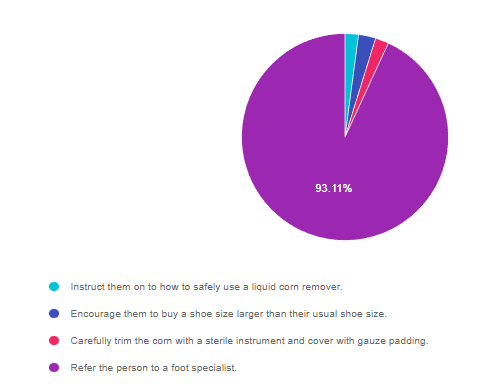
As shown above, the most common choice was option 4, the second most common answer was option 2, then a tie for options 1 and 3.
Getting to the Best Answer
Answer 1 is incorrect. 2.10% chose this answer, “Instruct them on to how to safely use a liquid corn remover.” The problem with corn and callus liquid or patch treatments, is that they contain salicylic acid, which can remove the callus/corn, but also damage the healthy tissue underneath. This disruption in skin integrity can lead to ulcerations and increase the risk of skin infections, especially if the person with diabetes is experiencing blood glucose elevations. We have created foot care education sheets in English and Spanish that you are invited to print and share. Let’s prevent the agony of “DeFeet”. Foot Care Teaching Sheet – Steps to Healthy Feet. Foot Care Teaching Sheet in Spanish– Pasos Para Tener Pies Sanos.
Answer 2 is incorrect. 2.69% of you chose this answer, “Encourage them to buy a shoe size larger than their usual shoe size.” While it is important to make sure there is plenty of room to wiggle toes and avoid rubbing from tight fitting shoes, it is also important to avoid ill fitting shoes. Wearing too large of shoes can lead to slippage and increased friction resulting in blisters and ulcers. These teaching sheets demonstrate an easy strategy to make sure that people are wearing the best size shoes for their foot shape. Foot Care Teaching Sheet – Steps to Healthy Feet. Foot Care Teaching Sheet in Spanish– Pasos Para Tener Pies Sanos.
Answer 3 is incorrect. 2.10% of respondents chose this answer, “Carefully trim the corn with a sterile instrument and cover with gauze padding.” People diabetes are strongly discouraged from performing any “bathroom surgery” to self-treat foot problems. Approved foot care tools for foot care include, nail clippers, nail file, soap and water, washcloth, gentle scrub brush, lotions, socks and shoes. We have created foot care education sheets in English and Spanish that you are invited to print and share. Let’s prevent the agony of “DeFeet”. Foot Care Teaching Sheet – Steps to Healthy Feet. Foot Care Teaching Sheet in Spanish– Pasos Para Tener Pies Sanos.
Finally, Answer 4 is incorrect. 93.11% chose this answer, “Refer the person to a foot specialist.” GREAT JOB. Most people chose this answer for good reason, the action of referring a person with foot problems to a Podiatrist significantly reduces the risk of ulceration, infection and amputation. By identifying and referring people with high risk feet to specialists, we can reverse the trend of increasing amputations and improve quality of life. We are happy to share these free lower extremity education handouts with you. Please feel free to print and share! Foot Care Teaching Sheet – Steps to Healthy Feet. Foot Care Teaching Sheet in Spanish– Pasos Para Tener Pies Sanos.
Want to learn more about this question?
Enroll in our Foot Screening Bundle, now on Sale!
This bundle includes our 3 Steps to Save Feet; Assess, Screen, and Report Webinar + 20-pack of Monofilament + ADA Foot Screening Chart
People with diabetes are at increased risk of foot complications. Basic foot care education and intervention can reduce the risk of amputation by over 50 percent.
This bundle comes with our:
We have included instructions on assessing and inspecting feet, risk assessment, and action steps. We enhanced the teaching tools and forms from the Lower Extremity Prevention Program (LEAP) and are excited to share them with our community of diabetes advocates.
FREE Resources for Health Care Professionals and People with Diabetes
3 Steps to Save Feet – Assess, Screen, Report Handout. This handout walks health care professionals through the steps involved in a 10-minute foot assessment and monofilament screening. Also includes a Screening Form to document and report findings.
Foot Care Teaching Sheet – Steps to Healthy Feet. This handout covers the important elements of foot care for people living with diabetes with simple and straightforward language.
Foot Care Teaching Sheet in Spanish– Pasos Para Tener Pies Sanos. This handout covers the important elements of foot care for people living with diabetes with simple and straightforward language.
FREE Handouts and Resources
Read More: FREE Handouts and Resources 3 Steps to Save Feet – Assess, Screen, Report Handout. This handout walks health care professionals through the steps involved in a 10-minute foot assessment and monofilament screening. Also includes a Screening Form to document and report findings. Foot Care Teaching Sheet – Steps to Healthy Feet. This handout covers the important elements of foot care for people living with diabetes with simple and straightforward language. Foot Care Teaching Sheet in Spanish– Pasos Para Tener Pies Sanos. This handout covers the important elements of foot care for people living with diabetes with simple and straightforward language. Sign up for Diabetes Blog Bytes – we post one daily Blog Byte from Monday to Friday. And of course, Tuesday is our Question of the Week. It’s Informative and FREE! Sign up below! The use of DES products does not guarantee the successful passage of the CDCES exam. CBDCE does not endorse any preparatory or review materials for the CDCES exam, except for those published by CBDCE. For last week’s practice question, we quizzed test takers on the best use of monofilament to check feet. 60% of respondents chose the best answer. We want to share this important information, so you can pass it on to people living with diabetes and your colleagues, plus prepare for exam success! Before we start though, if you don’t want any spoilers and haven’t tried the question yet, you can answer it below: Answer Question Question: ADA Standards of Care recommend using a 5.07 monofilament to evaluate for loss of protective sensation in lower extremities in people with diabetes. Which of the following statements is most accurate regarding using a monofilament to assess lower extremities? Answer Choices: As shown above, the most common choice was option 1, the second most common answer was option 4, then option 2, and finally 3. Answer 1 is correct. 60.00% chose this answer, “When using the monofilament, test above or below thickened or callused skin.” YES, GREAT JOB. Many people with diabetes have calluses and thickened skin that will block the sensation of 10gms of linear pressure delivered by the monofilament. For this reason, avoid areas with thickened insensate skin and test for sensation above or below the callused location. Answer 2 is incorrect. 11.27% of you chose this answer, “Be careful not to bend the monofilament when testing for sensation.” Actually, to deliver 10gms of linear pressure using a monofilament, the examiner needs to slightly bend the 5.07 filament into a “C” position. This will deliver the correct amount of pressure to evaluate if the person is experiencing loss of sensation. Answer 3 is incorrect. 4.13% of respondents chose this answer, “Alternate between hot and cold testing with monofilament testing to enhance accuracy.” Hot and cold testing is a strategy to determine if the person has decreased temperature sensation. However alternating between these two assessment techniques won’t enhance the testing accuracy of the monofilament. Finally, Answer 4 is incorrect. 24.60% chose this answer, “Rotate monofilament testing between the medial malleolus and distal phalanges for best results.” This is a juicy answer with some cool foot terms. The medial malleolus is actually the bump that protrudes on the inner ankle and the distal phalanges are the tips of the toes. The inner ankle is not one of the points of assessment using a monofilament. The large toe, the foot pad and heel are locations included in a foot assessment using a 5.07 monofilament. All health care professionals are invited to join us to learn strategies to protect lower extremities during this FREE Webinar. Coach Beverly will walk participants through the 3 Step Process to Save Feet; Assess, Screen and Report. She will provide simple and clear instructions on how to assess and inspect feet, along with risk assessment and action steps. We will share free teaching tools, strategies, and documentation forms adapted from the Lower Extremity Prevention Program (LEAP) that you can immediately implement in your practice setting. CEs: 1.0 CEs for $19 or No CEs for FREE Topics include: Read More: FREE Handouts and Resources 3 Steps to Save Feet – Assess, Screen, Report Handout. This handout walks health care professionals through the steps involved in a 10-minute foot assessment and monofilament screening. Also includes a Screening Form to document and report findings. Foot Care Teaching Sheet – Steps to Healthy Feet. This handout covers the important elements of foot care for people living with diabetes with simple and straightforward language. Foot Care Teaching Sheet in Spanish– Pasos Para Tener Pies Sanos. This handout covers the important elements of foot care for people living with diabetes with simple and straightforward language. Coach Beverly Thomassian, RN, MPH, BC-ADM, CDCES Author, Nurse, Educator, Clinician and Innovator, Beverly has specialized in diabetes management for over twenty years. As president and founder of Diabetes Educational Services, Beverly is dedicated to optimizing diabetes care and improving the lives of those with diabetes. People with diabetes are at increased risk of foot complications. By using a 5.07 monofilament (delivers 10gms of linear pressure) to assess for loss of sensation, diabetes health care professionals can immediately identify high-risk feet and take steps to protect lower extremities. Basic foot care education and intervention can reduce the risk of amputation by over 50 percent. We are excited to provide these single-use 5.07 monofilaments in packs of 20. We have included instructions on how to assess and inspect feet, along with risk assessment and action steps. We enhanced the teaching tools and forms from the Lower Extremity Prevention Program (LEAP) and are excited to share them with our community of diabetes advocates. Whether you are new to diabetes or a seasoned expert, you’ll benefit from this virtual conference with the latest research plus critical content that you can immediately apply to your clinical practice. Download Course Flyer | Download Schedule If you are seeking a state-of-the-art review of current diabetes care, this course is for you. Our team has been fine-tuning this course for over fifteen years, and we know what you need. This program can also be a great addition to your CDCES or BC-ADM exam study plan. Team of expert faculty includes: Don’t worry if you can’t make it live. Your registration guarantees access to the recorded version in the Online University. All hours earned count toward your CDCES Accreditation Information Sign up for Diabetes Blog Bytes – we post one daily Blog Byte from Monday to Friday. And of course, Tuesday is our Question of the Week. It’s Informative and FREE! Sign up below! The use of DES products does not guarantee the successful passage of the CDCES exam. CBDCE does not endorse any preparatory or review materials for the CDCES exam, except for those published by CBDCE. For last week’s practice question, we quizzed test takers on Mounjaro, a new medication. 82% of respondents chose the best answer. We want to share this important information, so you can pass it on to people living with diabetes and your colleagues, plus prepare for exam success! Before we start though, if you don’t want any spoilers and haven’t tried the question yet, you can answer it below: Answer Question Question: The FDA recently approved the new ‘twincretin” dual incretin hormone therapy called Tirzepatide (Mounjaro). The provider wants to start a person with type 2 diabetes on this new medication and asks for your consultation. The person’s current medications for type 2 diabetes include metformin, empagliflozin (Jardiance), semaglutide (Ozempic), and Pravachol. What is the best response to the provider? Answer Choices: As shown above, the most common choice was option 2, the second most common answer was option 4, then option 1, and finally 3. Answer 1 is incorrect. 6.53% chose this answer, “Inform provider that Tirzepatide (Mounjaro) is contraindicated in people taking SGLT-2 Inhibitors.” According to the Package Insert, Tirzepatide can be used in combination with SGLT-2 Inhibitors and other approved diabetes medications. However, since Tirzepatide is a combination of GLP-1 and GIP Incretins, it is not recommended to use in combination with a GLP-1 RA or the DPP-IV class of medications. Read more on our blog here. Answer 2 is correct. 82.13% of you chose this answer, “Recommend stopping the semaglutide (Ozempic) before starting the Tirzepatide (Mounjaro).” YES, GREAT JOB! Since Tirzepatide is a combination of GLP-1 and GIP Incretins, it is not recommended to use in combination with a GLP-1 RA or the DPP-IV class of medications. Answer 3 is incorrect. 4.12% of respondents chose this answer, “Reinforce the importance of prescribing a CGM before starting Tirzepatide (Mounjaro).” Since this person is not on insulin or any medications that would cause low blood sugar, a CGM is not required to monitor blood sugars. Blood glucose monitoring combined with regular A1C testing will be important to determine the efficacy of this new “twincretin”. Read more on our blog here. Finally, Answer 4 is incorrect. 7.22% chose this answer, “Request provider also prescribes Glucagon rescue med in case of severe hypoglycemia.” Since this person is not on insulin or any medications that would cause low blood sugar, a glucagon rescue med is not required to treat severe hypoglycemia. Blood glucose monitoring combined with regular A1C testing will be important to determine the efficacy of this new “twincretin”. Read more on our blog here. The FDA just approved a novel, dual incretin hormone therapy called Tirzepatide (Mounjaro). This new twin incretin injectable includes not only a GLP-1 Receptor Agonist, but also a Glucose-dependent insulinotropic polypeptide (GIP), which magnifies the therapeutic effectiveness. The SURPASS studies indicate that study participants experienced an A1C drop of up to 2.5% and weight loss of up to 10kg or more. Whether you are new to diabetes or a seasoned expert, you’ll benefit from this virtual conference with the latest research plus critical content that you can immediately apply to your clinical practice. Download Course Flyer | Download Schedule If you are seeking a state-of-the-art review of current diabetes care, this course is for you. Our team has been fine-tuning this course for over fifteen years, and we know what you need. This program can also be a great addition to your CDCES or BC-ADM exam study plan. Join us LIVE for this Virtual Course and enjoy a sense of community! Team of expert faculty includes: Deluxe Option for $499: Virtual Program includes: Deluxe Version includes Syllabus, Standards and Swag*: Basic Option for $399: Virtual Program includes: Don’t worry if you can’t make it live. Your registration guarantees access to the recorded version in the Online University. All hours earned count toward your CDCES Accreditation Information Sign up for Diabetes Blog Bytes – we post one daily Blog Byte from Monday to Friday. And of course, Tuesday is our Question of the Week. It’s Informative and FREE! Sign up below! The use of DES products does not guarantee the successful passage of the CDCES exam. CBDCE does not endorse any preparatory or review materials for the CDCES exam, except for those published by CBDCE. For last week’s practice question, we quizzed test takers on the best blood sugar fix. 64% of respondents chose the best answer. We want to share this important information, so you can pass it on to people living with diabetes and your colleagues, plus prepare for exam success! Before we start though, if you don’t want any spoilers and haven’t tried the question yet, you can answer it below: Answer Question Question: LS wears an insulin pump and uses lispro insulin. LS has an average basal rate of 0.6 units and hour, a 1:15 carb ratio and a 1:50 correction ratio. Based on the ambulatory glucose profile, LS is experiencing elevated glucose levels from 4am to 7am. To get glucose to target, what is the best next step? Answer Choices: As shown above, the most common choice was option 4, the second most common answer was option 1, then option 2, and finally 3. Answer 1 is incorrect. 16.26% chose this answer, “Add basal insulin glargine to prevent Somogyi effect.” Since LS uses an insulin pump, they don’t need to inject additional basal insulin (glargine) to get overnight blood sugars to target. With an insulin pump, the bolus insulin (lispro) acts as the basal insulin, delivering background insulin at 0.6 units an hour. In addition, Simogyi is defined as rebound hyperglycemia, or the sudden increase in blood sugars, due to stress hormones, after a significant hypoglycemic event. There is no symptoms in the question that indicate that LS is experiencing a Somogyi event. This is a juicy answer, but on closer inspection, not the best one. Answer 2 is incorrect. 14.63% of you chose this answer, “Make sure LS isn’t consuming carbohydrates after 10pm.” Based on the glucose profile, LS blood sugars are increasing around 4am, which is most likely due to the Dawn Phenomena, not late night snacking. In the middle of the night, the body starts releasing growth hormone cortisol, and catecholamines, which causes an increase in blood sugars around 4am for many people with type 1 diabetes. This is referred to as the Dawn Phenomena. The best way to manage this is to slightly increase basal rate during the period when blood sugar is on the rise. Answer 3 is incorrect. 4.88% of respondents chose this answer, “Ask LS to double check their CGM insertion site.” While it’s always good to check to make sure devices are working properly, this isn’t the case for this question. LS is having consistent glucose elevations from 4am to 7am, which is commonly referred to as the Dawn Phenomena. In the middle of the night, the body starts releasing growth hormone cortisol, and catecholamines, which causes an increase in blood sugars around 4am for many people with type 1 diabetes. The best way to manage this is to slightly increase basal rate during the period when blood sugar is on the rise. Finally, Answer 4 is correct. 64.23% chose this answer, “Increase the basal rate to prevent glucose elevations.” YES, GREAT JOB. LS is having consistent glucose elevations from 4am to 7am, which is commonly referred to as the Dawn Phenomena. In the middle of the night, the body starts releasing growth hormone cortisol, and catecholamines, which causes an increase in blood sugars around 4am for many people with type 1 diabetes. The best way to manage this is to slightly increase basal rate during the period when blood sugar is on the rise. Learn Test-Taking Secrets with Coach Bev – Option to add on 200+ Computerized Practice Test Questions for $49 During this webinar, Coach Beverly will help you transform your nervousness into focused energy that will help you succeed. She will provide test-taking tips based on her experience taking the certification exam six times. To provide plenty of practice, Coach Beverly will sample 20 test questions that have been plucked from our Test Taking Toolkit during this live webinar. She will explain how to dissect the question, eliminate wrong answers and avoid getting lured in by juicy answers. Includes a review of 20 sample test questions with test taking strategies. This includes access to the recorded version of this webinar on your Online University Student Portal. Plus, the Test Taking Toolkit provides you with over 200+ sample online practice questions, simulating the exam experience. A perfect way to assess your knowledge and create a focused study plan, while increasing your test-taking confidence. Whether you are new to diabetes or a seasoned expert, you’ll benefit from this virtual conference with the latest research plus critical content that you can immediately apply to your clinical practice. Download Course Flyer | Download Schedule If you are seeking a state-of-the-art review of current diabetes care, this course is for you. Our team has been fine-tuning this course for over fifteen years, and we know what you need. This program can also be a great addition to your CDCES or BC-ADM exam study plan. Join us LIVE for this Virtual Course and enjoy a sense of community! Team of expert faculty includes: Deluxe Option for $499: Virtual Program includes: Deluxe Version includes Syllabus, Standards and Swag*: Basic Option for $399: Virtual Program includes: Don’t worry if you can’t make it live. Your registration guarantees access to the recorded version in the Online University. All hours earned count toward your CDCES Accreditation Information Sign up for Diabetes Blog Bytes – we post one daily Blog Byte from Monday to Friday. And of course, Tuesday is our Question of the Week. It’s Informative and FREE! Sign up below! The use of DES products does not guarantee the successful passage of the CDCES exam. CBDCE does not endorse any preparatory or review materials for the CDCES exam, except for those published by CBDCE. For last week’s practice question, we quizzed test takers on MR who was recently diagnosed with diabetes at age 13. 70% of respondents chose the best answer. We want to share this important information, so you can pass it on to people living with diabetes and your colleagues, plus prepare for exam success! Before we start though, if you don’t want any spoilers and haven’t tried the question yet, you can answer it below: Answer Question Question: MR is 13 years old, and went to urgent care because they weren’t feeling well and told the Provider “I feel so tired all the time and I have to go the bathroom a lot”. The provider draws labs and gets a urine sample. The A1C is 8.7% with some ketones in the urine. The antibody results aren’t back yet. Based on the ADA Standards and this information, what is the best action? Answer Choices: As shown above, the most common choice was option 1, the second most common answer was option 2, then option 4, and finally 3. Answer 1 is correct. 69.78% chose this answer, “Start MR on basal insulin.” YES, GREAT JOB. This is the best answer according to ADA Standard 14 on Diabetes and Youth. If a person under the age of 18 has new-onset diabetes and an A1C of 8.5% or greater, basal insulin is needed to get blood glucose to target and stop ketosis. The next step is to determine if they have immune-mediated diabetes by evaluating their autoantibodies. If they don’t have autoantibodies (GAD, ICA, IAA), then the guidelines suggest starting metformin and gradually decreasing the insulin to see if they can be managed on metformin alone or with the addition of a GLP-1 RA. If the antibodies come back positive, MR would need to be managed on basal-bolus insulin therapy. Answer 2 is incorrect. 13.71% of you chose this answer, “Order a nutrition consult ASAP and provide MR with a meter.” This is a juicy answer since a nutrition consult and meter are critical to managing a new diabetes diagnosis. However, we would provide the nutrition consult after we figure out what type of diabetes and after lowering blood glucose levels with insulin to prevent a hyperglycemic crisis. Regardless of the type of diabetes, ordering a meter right away and providing basic nutrition guidelines are both critical steps to keep MR safe and to evaluate treatment response. Answer 3 is incorrect. 6.70% of respondents chose this answer, “Initiate GLP-1 therapy to help lower glucose and A1C.” Since the A1C is above 8.5%, the ADA Standards state to start basal insulin to lower glucose and prevent hyperglycemic crises. If the autoantibodies come back negative, we would start metformin therapy and consider a GLP-1 RA as a future add-on therapy. Finally, Answer 4 is incorrect. 9.81% chose this answer, “Start metformin therapy, then add exenatide XR if needed.” Since the A1C is above 8.5%, the ADA Standards state to start basal insulin to lower glucose and prevent a hyperglycemic crisis. If the autoantibodies come back negative, we would start metformin therapy and consider a GLP-1 RA as a future add-on therapy. Learn Test-Taking Secrets with Coach Bev – Option to add on 200+ Computerized Practice Test Questions for $49 During this webinar, Coach Beverly will help you transform your nervousness into focused energy that will help you succeed. She will provide test-taking tips based on her experience taking the certification exam six times. To provide plenty of practice, Coach Beverly will sample 20 test questions that have been plucked from our Test Taking Toolkit during this live webinar. She will explain how to dissect the question, eliminate wrong answers and avoid getting lured in by juicy answers. Includes a review of 20 sample test questions with test-taking strategies. This includes access to the recorded version of this webinar on your Online University Student Portal. Plus, the Test Taking Toolkit provides you with over 200+ sample online practice questions, simulating the exam experience. A perfect way to assess your knowledge and create a focused study plan, while increasing your test-taking confidence. This course includes updated goals and guidelines for children living with type 1 or type 2 diabetes. This course discusses the special issues diabetes educators need to be aware of when working with children with diabetes and their families. We discuss the clinical presentation of diabetes, goals of care, and normal growth and development through the early years through adolescence. Strategies to prevent acute and long term complications are included with an emphasis on positive coping for family and child with diabetes. Objectives: The use of DES products does not guarantee the successful passage of the CDCES exam. CBDCE does not endorse any preparatory or review materials for the CDCES exam, except for those published by CBDCE. For last week’s practice question, we quizzed test takers on fatty liver disease. 57% of respondents chose the best answer. We want to share this important information, so you can pass it on to people living with diabetes and your colleagues, plus prepare for exam success! Before we start though, if you don’t want any spoilers and haven’t tried the question yet, you can answer it below: Answer Question Question: 45 to 75% of individuals with type 2 diabetes have non-alcoholic fatty liver disease (NAFLD). NAFLD has associated with an increased risk of steatohepatitis, cirrhosis, and liver cancer. Which of the following statements is true based on ADA Standards of Care? Answer Choices: As shown above, the most common choice was option 3, the second most common answer was option 1, then option 2, and finally 4. Answer 1 is incorrect. 24.79% chose this answer, “Elevated ALT and AST indicate a diagnosis of NAFLD.” These two liver enzyme tests certainly indicate liver inflammation and are a signal that further investigation is warranted. However, to confirm and diagnose NAFLD, a comprehensive review of patient history, lab results, liver imaging studies and possibly a biopsy are required. Answer 2 is incorrect. 16.53% of you chose this answer, “Approved treatment for NAFLD includes low-dose aspirin and pioglitazone.” The cornerstones of treatment for NAFLD are nutrition therapy interventions with a focus on decreasing processed foods, sugary beverages and foods high in saturated fat. Plus, increasing intake of whole foods and committing to a structured physical activity plan to decrease visceral and hepatic adiposity is imperative. There is no officially approved medication to treat NAFLD, but pioglitazone and GLP-1 RA’s appear to decrease fatty liver based on current studies. Answer 3 is correct. 57.28% of respondents chose this answer, “Fatty liver disease indicates that 5-10% of the liver weight is from fat.” GREAT JOB, this is the best answer. The good news is that weight loss and increased activity are very effective in treating fatty liver disease. A weight loss of 7-10% linked with a 50% drop in liver fat. Every pound lost makes a big difference. The cornerstones of treatment for NAFLD are nutrition therapy interventions with a focus on decreasing processed foods, sugary beverages and foods high in saturated fat. Plus, increasing intake of whole foods and committing to a structured physical activity plan to decrease visceral and hepatic adiposity is imperative. Finally, Answer 4 is incorrect. 1.41% chose this answer, “Surgical intervention is indicated to resect the liver in the presence of NAFLD.” People with NAFLD and other risk factors, have an increased risk of disease progression to cirrhosis and liver cancer, which might require surgical intervention. However, no surgical intervention is warranted for NAFLD. The cornerstones of treatment for NAFLD are nutrition therapy interventions with a focus on decreasing processed foods, sugary beverages and foods high in saturated fat. Plus, increasing intake of whole foods and committing to a structured physical activity plan to decrease visceral and hepatic adiposity is imperative. Learn Test-Taking Secrets with Coach Bev – Option to add on 200+ Computerized Practice Test Questions for $49 During this webinar, Coach Beverly will help you transform your nervousness into focused energy that will help you succeed. She will provide test-taking tips based on her experience taking the certification exam six times. To provide plenty of practice, Coach Beverly will sample 20 test questions that have been plucked from our Test Taking Toolkit during this live webinar. She will explain how to dissect the question, eliminate wrong answers and avoid getting lured in by juicy answers. Includes a review of 20 sample test questions with test taking strategies. This includes access to the recorded version of this webinar on your Online University Student Portal. Plus, the Test Taking Toolkit provides you with over 200+ sample online practice questions, simulating the exam experience. A perfect way to assess your knowledge and create a focused study plan, while increasing your test-taking confidence. Whether you are new to diabetes or a seasoned expert, you’ll benefit from this virtual conference with the latest research plus critical content that you can immediately apply to your clinical practice. Download Course Flyer If you are seeking a state-of-the-art review of current diabetes care, this course is for you. Our team has been fine-tuning this course for over fifteen years, and we know what you need. This program can also be a great addition to your CDCES or BC-ADM exam study plan. Join us LIVE for this Virtual Course and enjoy a sense of community! Team of expert faculty includes: Deluxe Option for $449: Virtual Program includes: Deluxe Version includes Syllabus, Standards and Swag*: Don’t worry if you can’t make it live. Your registration guarantees access to the recorded version in the Online University. All hours earned count toward your CDCES Accreditation Information Sign up for Diabetes Blog Bytes – we post one daily Blog Byte from Monday to Friday. And of course, Tuesday is our Question of the Week. It’s Informative and FREE! Sign up below! The use of DES products does not guarantee the successful passage of the CDCES exam. CBDCE does not endorse any preparatory or review materials for the CDCES exam, except for those published by CBDCE. For last week’s practice question, we quizzed test takers on complications of hyperglycemia during pregnancy. 60% of respondents chose the best answer. We want to share this important information, so you can pass it on to people living with diabetes and your colleagues, plus prepare for exam success! Before we start though, if you don’t want any spoilers and haven’t tried the question yet, you can answer it below: Answer Question Question: AR has type 1 diabetes and is in shock because they just discovered they are 6 weeks pregnant. AR uses a CGM and insulin pump to manage their diabetes and their most recent A1C is 8.3%. Which of the following is a potential complication associated with hyperglycemia during the first 10 weeks of pregnancy? Answer Choices: As shown above, the most common choice was option 4, the second most common answer was option 1, then option 2, and finally 3. Answer 1 is incorrect. 17.20% chose this answer, “Macrosomia and post-natal jaundice.” This is a juicy answer since macrosomia and post natal jaundice are often associated with gestational diabetes (GDM) However, this question is not asking about GDM, which is usually diagnosed between 24-28 weeks of pregnancy. In this question, AR already has type 1 when becoming pregnant and wants to know the consequence of hyperglycemia during the first 10 weeks when the fetal organs are developing. Answer 2 is incorrect. 14.25% of you chose this answer, “Intrauterine hypoglycemia.” This answer is designed to lure the test taker in with the word hypoglycemia. A fetus who is exposed to excess glucose in utero is at risk of post natal hypoglycemia AFTER delivery, since they no longer are receiving maternal glucose and their pancreas is making abundant insulin. A fetus exposed to excess intrauterine glucose levels is at risk of hyperglycemia (not hypo). Answer 3 is incorrect. 8.85% of respondents chose this answer, “Neonatal respiratory distress.” This is a juicy answer since neonatal respiratory distress is often associated with GDM and diabetes in pregnancy. However, this question is not asking about post delivery complications. In this question, AR already has type 1 when becoming pregnant and wants to know the consequence of hyperglycemia during the first 10 weeks when the fetal organs are developing. Finally, Answer 4 is correct. 59.71% chose this answer, “Diabetic embryopathy.” Yes, GREAT JOB, this is the best answer. The first trimester of fetal development is when the organs are developing. A fetus exposed to excess levels of glucose during this critical time is at increased risk of congenital defects like anencephaly, microcephaly, neural tube defects and others. For people with diabetes, achieving an A1C of less than 6.5% before conceptions improves outcomes and decreases risk of congenital anomalies. With careful planning and keeping a close connection with their health care team, people with diabetes can experience healthy pregnancies and great outcomes. Pregnancy with diabetes is confronted with a variety of issues that require special attention, education, and understanding. This course reviews those special needs while focusing on Gestational Diabetes and Pre-Existing Diabetes. Included are the most recent diagnostic criteria, management goals, and prevention of complications during pregnancy. A helpful review for the CDCES Exam and for those who want more information on people who are pregnant and live with Diabetes. Objectives: The use of DES products does not guarantee the successful passage of the CDCES exam. CBDCE does not endorse any preparatory or review materials for the CDCES exam, except for those published by CBDCE.
Rationale of the Week | How to use a Monofilament to Check Feet

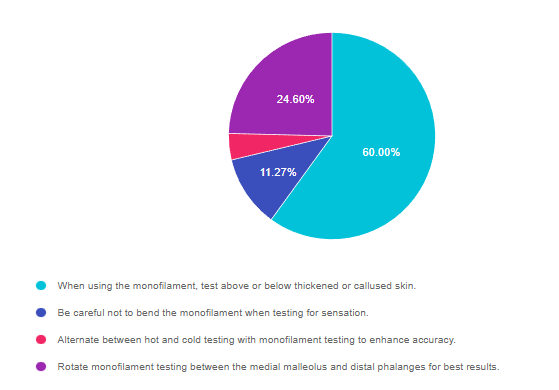
Getting to the Best Answer
Want to learn more about this question?
Join us for our new FREE Webinar
3 Steps to Save Feet; Assess, Screen, and ReportAirs live July 19th at 11:30 am PST (45 to 60 minutes)
Can’t join us live?
Don’t worry, we will send you a link to the recorded version.FREE Handouts and Resources

NEW! Order Monofilament (5.07) for Diabetes Foot Screening 20-Pack

Want to learn more about Diabetes Care? Join us for our
Virtual DiabetesEd Specialist Conference
30+ CEsAirs October 12-14th, 2022
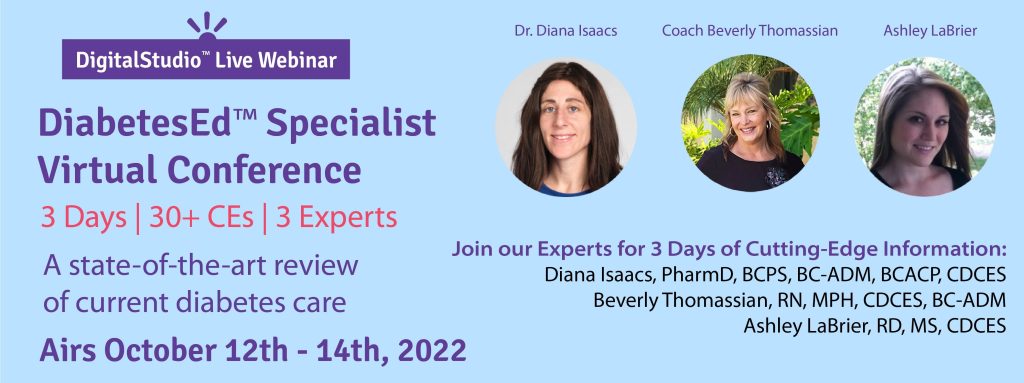
Join us LIVE for this Virtual Course and enjoy a sense of community!
Two Registration Options
Rationale of the Week | Best advice on adding new med, Mounjaro

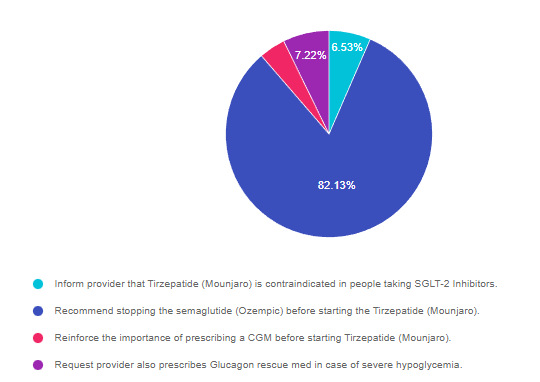
Getting to the Best Answer
Want to learn more about this question?
New Dual Incretin Injectable – “TwinCretin”
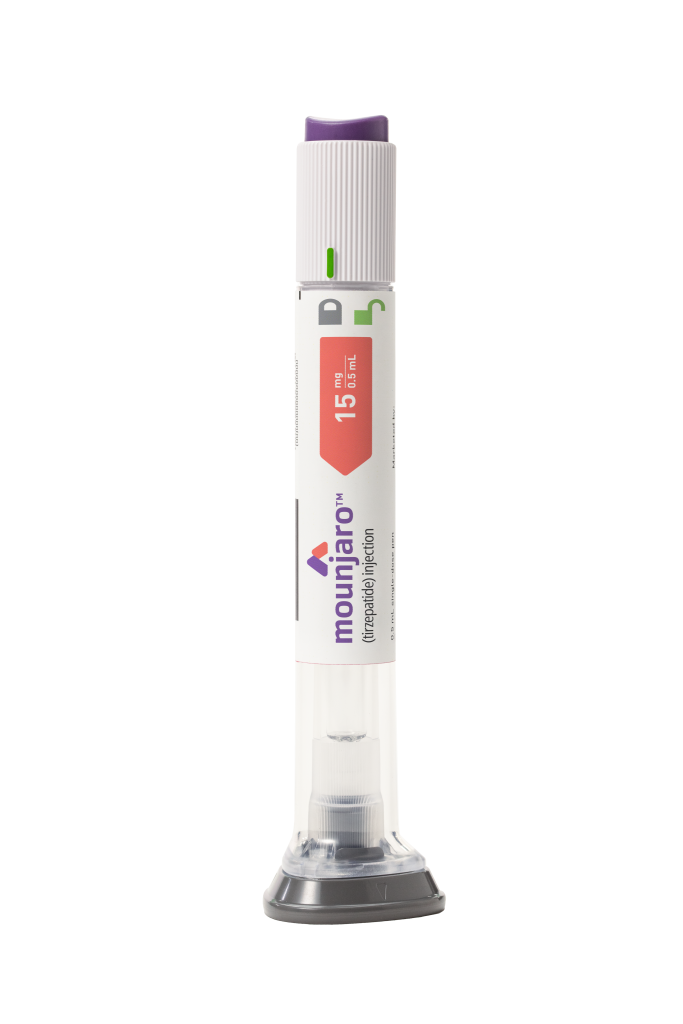
Want to learn more about Diabetes Care? View our
Virtual DiabetesEd Specialist Conference
30+ CEsAirs October 12-14th, 2022

Two Registration Options
Virtual DiabetesEd Specialist Conference Deluxe | 30+ CEs
Virtual DiabetesEd Specialist Conference Basic | 30+ CEs
Rationale of the Week | Best blood sugar fix?

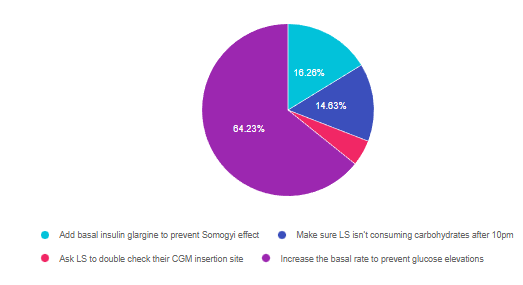
Getting to the Best Answer
Want to learn more about this question? Join us for our upcoming webinar
Test Taking Practice Exam Toolkit | FREE Webinar
Are You Ready for Exam Success?
Join us live Thursday, June 30th at 11:30 am PST
Two Ways to Join
Want to learn more about Diabetes Care? View our
Virtual DiabetesEd Specialist Conference
30+ CEsAirs October 12-14th, 2022

Two Registration Options
Virtual DiabetesEd Specialist Conference Deluxe | 30+ CEs
Virtual DiabetesEd Specialist Conference Basic | 30+ CEs
Rationale of the Week | New diabetes at 13, best next step?

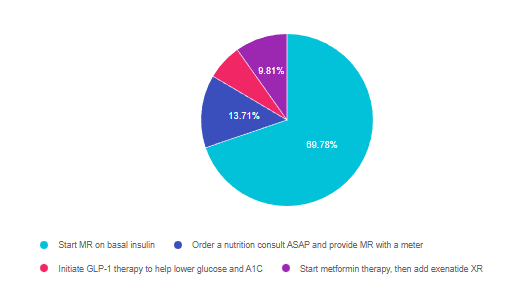
Getting to the Best Answer
Want to learn more about this question? Join us for our upcoming webinar
Test Taking Practice Exam Toolkit | FREE Webinar
Are You Ready for Exam Success?
Join us live Thursday, June 30th at 11:30 am PST
Two Ways to Join
From Tots to Teens | Level 2 | $29 for 1.5 CEs
Recorded & Ready to Watch!

Rationale of the Week | What is true about fatty liver disease?

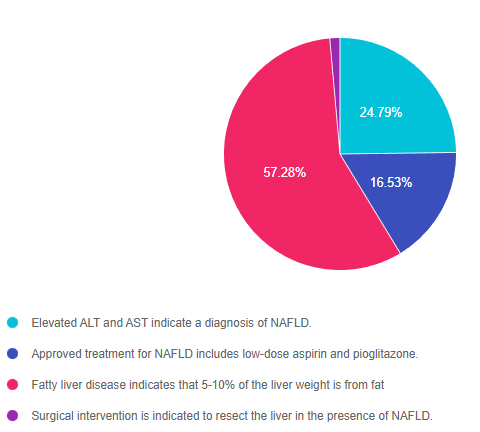
Getting to the Best Answer
Want to learn more about this question? Join us for our upcoming webinar
Test Taking Practice Exam Toolkit | FREE Webinar
Are You Ready for Exam Success?
Join us live Thursday, June 30th at 11:30 am PST
Two Ways to Join
Want to learn more about Diabetes Care? View our
Virtual DiabetesEd Specialist Conference
30+ CEsRecorded & Ready to Watch!
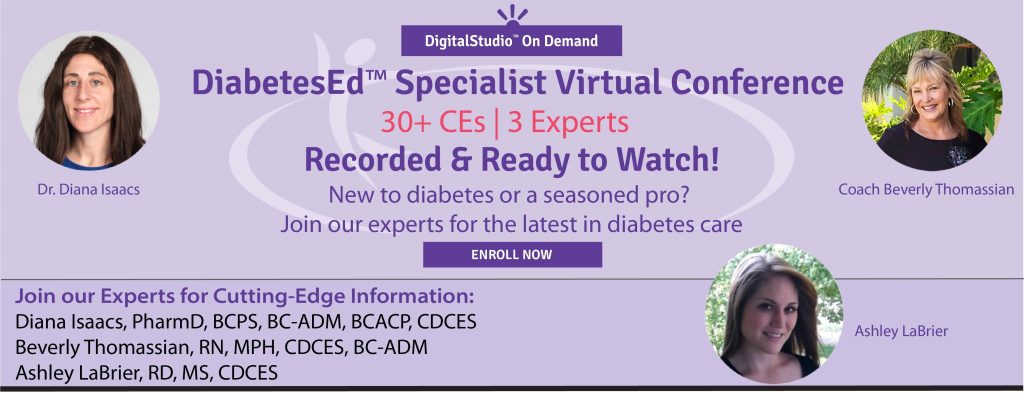
Virtual DiabetesEd Specialist Conference Deluxe | 30+ CEs
Rationale of the Week | Pregnancy Surprise with Type 1 Diabetes

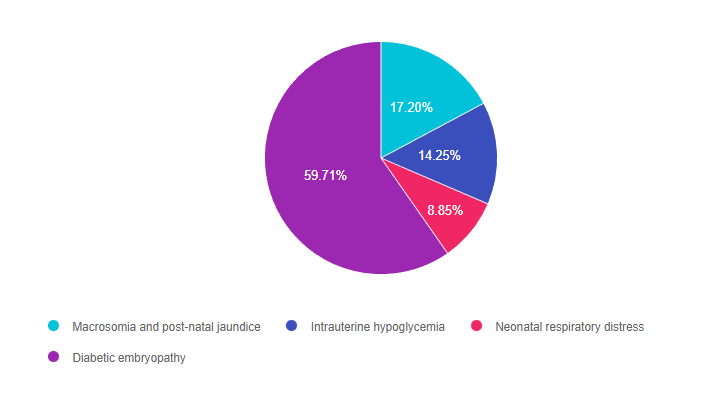
Getting to the Best Answer
Want to learn more about this question? Join us for our webinar
Pregnancy & Diabetes Standards | Level 2 | $29 for 1.5 CEs
Recorded & Ready to Watch!









